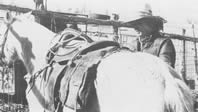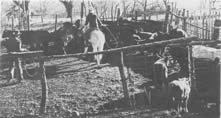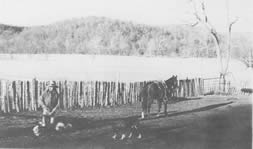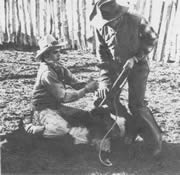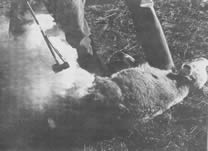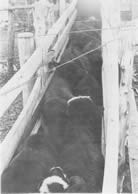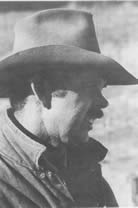 |
Volume X, No. 1, Fall 1982 |
ROUNDUP IN THE HILLS
ON THE BOB HANNEKEN CATTLE RANCH
by Chris Cotrel
Photography by James Heck, Chris Cotrel and Allen Gage
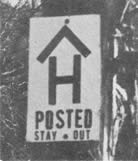 The smell of scorched hair and dust filled the cattle lots on the cold January day. Calves
temporarily separated from the herd bawled lustily, while their mothers bawled back as they paced
the fence frantically trying to get to them. The men on foot shouted at the calves, separating them
into different groups. In the biggest lot the horses' shoes struck against the rocky ground as the
two mounted boys swung their lariats over their heads and maneuvered their horses into better
positions. At one side the propane fire in a homemade tank sputtered continually, sending out
waves of heat from around the branding irons being heated. The hot branding irons sizzled when
pressed to a calf's hip, creating a cloud of white smoke and steam. Branded, ear-notched,
vaccinated and dehorned in a very few minutes, the released calf trotted through the opened gate
back to its mother, where it nursed greedily.
The smell of scorched hair and dust filled the cattle lots on the cold January day. Calves
temporarily separated from the herd bawled lustily, while their mothers bawled back as they paced
the fence frantically trying to get to them. The men on foot shouted at the calves, separating them
into different groups. In the biggest lot the horses' shoes struck against the rocky ground as the
two mounted boys swung their lariats over their heads and maneuvered their horses into better
positions. At one side the propane fire in a homemade tank sputtered continually, sending out
waves of heat from around the branding irons being heated. The hot branding irons sizzled when
pressed to a calf's hip, creating a cloud of white smoke and steam. Branded, ear-notched,
vaccinated and dehorned in a very few minutes, the released calf trotted through the opened gate
back to its mother, where it nursed greedily.
This scene is routine on cattle ranches anyplace cattle are raised in large numbers--a yearly job of giving identification and treatment to young calves. Traditionally in the United States the raising of cattle has been in the West, but this situation is changing. Farmers and ranchers in southwest Missouri are raising a great many cattle and sending them west to be fattened.
One such Missouri rancher is Bob Hanneken, who with his wife, Ann, and sons, Chris and Jeff, raise many head of Cattle on their hilly Ozark farm.
"Out west people have raised cattle for eighty or one hundred years, just as now they're starting in Missouri," said Bob. "It didn't used to be that way. Used to be, land in the Ozarks was in sixty, eighty or one hundred, sixty acres homesteads. Everyone had to have their pigs, their little cornfield for cornmeal. Out west, it wouldn't have done the people much good if they had wanted to have their cornfield, because it wasn't the right kind of country to grow corn. So they grew what they could. They grew cattle and sheep. Then they shipped them to the midwest states for feeding. Missouri, Iowa, and Illinois were big cattle feeding areas. They brought them from the west to here. Now it's just the opposite. Eastern Colorado and western Kansas are irrigated land now and they raise grain and feed there. That's getting to be the feed raising area and this is getting to be cattle raising area. There's more cattle goes up the interstate highway from Springfield, Missouri, to western Kansas and eastern Colorado than used to come the other way.
"Of course, everybody knows the stories of the old cow trails. They drove cattle up to the railroad towns. Dodge City is a feed lot town now, and instead of cattle being gathered at Dodge City and shipped east to feed, they are shipped to Dodge City and put into the feed lots there."
In the Ozarks the days of subsistence farming--living on a few hogs, chickens and home grown
products--have long passed. The small acreage farms are now combined into much larger
holdings. As the early settlers knew, the rough hill land and the lush valleys both grow grass to
support stock for almost eight months of the year. Therefore it was only logical that modern
farmers utilize the rougher lands unsuitable for grain crops to raise cattle. More and more people
like the Hannekens, by increasing their holdings of the less desirable rough lands, by working very
hard at clearing the land, improving it and planting it to pasture, have converted virtually waste
land into productive land that can produce feeder calves.
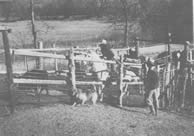 |
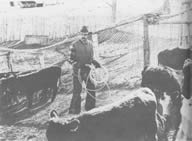 |
Bob and Ann Hanneken and their sons, Chris and Jeff, round up their cattle about twice a year from their hilly and rugged Ozark grazing grounds. Using horses and their dogs known as Wirey Haired Heelers, they run them into the holding pens preparatory to vaccinating, dehorning and branding. Everyone, people and cattle, is glad when these necessary tasks are finished. The cattle's health and safety depend on them.
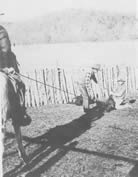 |
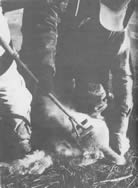 |
[33]
"Nobody wanted the land we have twelve years ago when we moved here because it was just all brush. They tried to clear some brush away and get some haying grass and feed crops to grow, but the brush grew right back. We try to fight back brush enough to where we can grow pasture, and we leave the land which is too steep anyway in brush. I guess the world needs a certain amount of that, too.
"It looks like there would be a lot of money in the cattle business because you're using poor Ozark land, the grass, the weeds and brush, to raise pounds of hamburger for McDonalds or whoever. But with interest and all the expenses, it really is not. Of course, we think we're pretty rich, but as far as lots of money, you can see by the way we live and the way we make do that it's not a real profitable business. It's like most farming. But the inflation in the price of land helps you think that you're making money."
The roundup would be almost impossible without horses. Bob tightens up his horse's shoe (below) while Chris gathers up his roping supplies and checks the girth to his saddle for the ride into the hills after their cattle.
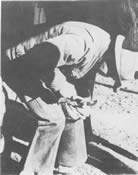
For people like the Hannekens who run hundreds of cattle, branding or some means of identifying cattle, is a necessity. Bob explained, "Branding has kept us from mixing cattle with the neighbors if they got out. One time right here in the creek bottom a big old flood came up in the middle of the night. There was about a hundred and sixty-five yearlings in the field when it hit. We could've been hurt terrible. It washed about half of them away. Because we had the brands on them, we got them all back except for about six.
"And another reason branding is necessary, whether you like it or not, people steal cattle. The world we live in is nice, still there's houses broke into all the time, and cattle are one of the easiest things to take for thieves who wants to turn property into money. If your cattle are not branded, try putting two or three head into a herd of 8,000 head. Then go to Springfield at the stockyards some Thursday yourself and see if you can pick them out. You can't do it. If they've got a hide brand on them, well, that's proof they're yours."
Some farmers have been branding in Missouri from earliest settlement, but it was never as widespread a practice as it was in the western states. Most farmers didn't used to run cattle in great numbers. "If someone has only two dozen cows, they know everyone of them by name," Bob said. "But the way it is now, the banker doesn't even want to talk to you as a cattle raiser unless you are talking about 100, 200, 300 mother cows. Now to protect your property you have to brand or mark them in some way."
[34]
A brand is an identification mark that is burned into the hide of livestock by a hot iron or another method such as using chemicals. In order for the brand to be used as evidence of ownership in the courts, it must be approved and recorded by the Commissioner of Agriculture. The brand must be at least three inches in diameter. In Missouri in 1974 there were 5,413 brands recorded.
It takes men on horseback and on foot to cut out the calves that need attention. Bob and Chris gently separate the smaller calves from their mothers. One calf, already run into another pen, looks on curiously at the moving mass of cattle, while the men with ropes, and many whoops and hollers cut into the herd.
The branding iron is a piece of metal molded or fashioned into the design wanted for the brand. This metal design is fastened to a handle.
Choosing the design itself is important. "A lot of people come up with brands that are too complicated," Bob said. "Big old scrolls and things like that really look pretty when the blacksmith makes the iron up, but whenever you put it on the animal, the middle part all blotches. The heat burns across from one part of the design to another. In other words, it kills the hair follicles in other places than what the iron touches. B's, or any closed letter, doesn't really make a good brand. K's blotch bad. A Q or a number 8 is real bad to blotch."
Each brand accepted for registration needs to be different. The owner also must indicate where
the brand goes on the animal, choosing one of the six accepted locations--right and left hip, right
and left shoulder, right and left rib. When the Hannekens wanted to use a big letter H and found
that others in the state had it registered, they put one over the other,
, and had it
registered in all six locations on the animal.
The Hannekens have devised a homemade tank-stove to heat the branding irons. "I still like a wood fire better," Bob said, "but this is much faster." There is no waiting for the brand to heat. Right--A close up of the branding iron.
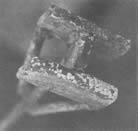
[35]
Heating the iron was originally done by putting the irons into the coals of a wood fire. It usually took quite a while to heat the irons to the temperature needed, but the heat was hot enough to keep the irons clean.
The Hannekens use propane fuel to heat their irons because it is quicker. "In two minutes your propane fire has your irons hot. With wood you have to wait. But I like a wood fire. Propane is noisy and sounds like a factory."
There are many different jobs that must be done before the actual branding takes place. First of all there is the rounding up of the scattered cattle. Bob and his boys do this on horseback with the aid of a breed of dogs unique to southwest Missouri, the Wirey Haired Heelers. He said, "In a triangle of country between Lebanon, Buffalo and Springfield, there's more of these dogs than any place that I know of. I used to know them as Wirey Haired Heelers. Then I got to dealing with people in the Conway and Buffalo area and they called them Wirey Mouth Heelers. Then you'll get into another community and they'll call them Hairy Mouthed Heelers. People think they're Airedales because they look like Airedales, but they're not. They're an extra good dog for brushy country and for cattle that's hard to handle. A lot of times we get calls to go help other people get cattle out of brushy pasture. Sometimes you can't even see the cattle and this dog can find cattle just by catching the scent in the air or on the ground just like a hunting dog. He'll hunt cattle just by smelling the wind like a bird dog. You have to see him to appreciate it. He can find cattle that you wouldn't even believe was in the pasture."
While his horse holds the calf from one direction and another taut rope holds him firmly from the front, Jeff is preparing to tie its legs. Thus secured, it lies still so the men can take care of the calf's health's needs and put on the brand with a minimum of discomfort to the calf. In a matter of minutes the calf is released to rejoin its mother.
The horses also play a very important role in rounding up the cattle. The brahma crossed cattle Bob raises are easily excited when handled on foot, but tend to work easily with horses.
The Hannekens use horses from the very beginning to herd the cows and calves together and drive them into a big holding pen. Then, with the aid of men on foot, the horsemen separate the calves into different pens depending upon their size and whet/set they have been branded already.
To facilitate this sorting, the Hannekens have constructed a series of pens, one for the larger calves and one for the smaller calves that are to be branded, one for those that do not need to be branded, a pen to accommodate roping and bulldogging the smaller calves and a long chute to use in branding the larger animals.
[36]
When everything is ready, Bob lets the smaller calves one at a time into the largest pen where one of the boys ropes them from horseback. Once they have been roped, the horse is trained to keep the rope taut to prevent the calf from running. Someone bulldogs, or throws, the calf to the ground and binds three of its legs to prevent it from escaping. When the legs are securely tied, the rope from the horse is removed.
The roundup is not solely for branding. While the cattle are caught, they are vaccinated, dehorned, ear-notched and castrated. Ann does all the branding because it is the safest job. Bob and the boys do the sorting, roping, tying, dehorning, ear notching and castrating. Whoever gets a spare moment vaccinates the animals.
The actual process of branding is fairly simple. The two or three branding irons remain with the heads in the homemade propane fueled heater tank until ready to use. The flame heats the irons to a hot enough temperature to sterilize the iron and put the brand on the animal quickly. With the calf held immobile, Ann presses the hot iron to its hip. The iron burns away the hair and goes into the hide just enough to kill the hair follicles. The contact is for only a few seconds. Then Ann puts that iron back in the stove to reheat.
"We're vaccinating with vitamin A and blackleg," said Ann. Some of these will have to be done again because they're so small. A lot of people when branding give fifteen or twenty different shots, but we try not to do that. We like to think that our stuff is a little tougher. I think that they need to build up their own resistance. The shots we give are blackleg, which is just as necessary as smallpox is to people, and vitamin A. We use vitamin A in the winter because there's not much green in the grass."
Jeff and Bob tie the calf securely.
The steam from the hot iron (above) fogs the frigid air as Ann brands with the Hanneken brand which is H lying over H (below).
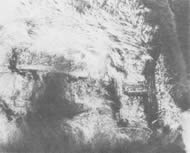
[37]
They notch the ears for identification at a distance by cutting a small V. Inserting ear tags is another means of identification. Since the Hannekens have quite a bit of brush on their place, they prefer notching the ears. The cattle could catch the tag in the brush and pull it out.
The dehorning is the process of cutting the little horn buds off with a small hand-held tool. Removing the horns is a safety measure to prevent injuries to other cattle and people. Dehorning is also the most risky part of the calves. Sometimes the wound hemorrhages. If the bleeding does not stop soon, the wound has to be cauterized. The wounds are then covered with tar to reduce infection and protect them from flies.
The Hannekens handle the larger animals in a metal squeeze chute. They run them up a narrow wooden chute to the chute. When they stick their heads out the opening, someone clamps it shut, trapping the animal. A bar fastened behind the calf holds it immobile. Thus secured in this position, it is not too difficult to brand it and tend to the other needs of the calf with comparative safety to the worker and the calf.
Bob does not work small calves in the chute for the calves' safety. They are so small that they tend to get turned upside down inside the squeeze chute and can severely hurt themselves.
After completing the branding and other treatments, the men release the calves to return to their mothers and the pastures. The freed animals display a variety of action. They run and jump, shake their heads, walk stiffly and in other ways show their pleasure in being free and the results of the doctoring, dehorning, castrating and branding. The Hannekens keep a close watch over them for a day or two to look for any problems.
Handling the larger calves is a bit easier. The Hannekens run them up the narrow chute (above) to a metal squeeze chute (below). One at a time they are let in the squeeze chute where they are held firmly by the neck. Thus secured, the men are able to work on the calves. Because of the small size of the little calves, they are handled by hand to prevent injuries.
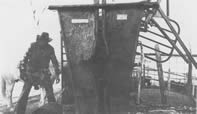
[38]
All the work done on the animals is vital for their own health and safety and is necessary protection of the rancher's investment of time, work and money.
"Some people are against branding," Bob said "and are always pampering their cattle, but we have our own philosophy about our cattle. It's not anything unnatural to the animal. We try to leave cattle alone 'til two times a year. A lot of people are constantly fooling with cattle. Every couple of weeks they're gathering them and doing something different with them. To do this you have pampered cattle. Docile, pampered cattle won't do very good in rough pasture land. Our cattle are a little bit tough and a little bit wild. Cattle have to be taught to do good on rough land like we have here.
"As far as pain, yeah, it hurts. When we get vaccinated as people, we think that hurts pretty bad, too. Three, four, five, six year olds, every spring came around we'd get vaccinated. We thought we were hurting pretty bad. Well, that's not burning a hole in your hide. But you can't compare people with cattle because cattle have a lot different tolerance to pain than we have. Cattle have a lot different tolerance to pain than, for instance, house cats. House cats couldn't stand pain as much as you can or certainly not what cattle can. But it would be ridiculous to try to pamper your cattle like you do your cats, because you know their tolerance is different. It's like in the roping sport. Some people think that it's terribly cruel, but if it is so terribly cruel, the calf wouldn't run to the other end of the ring and stick his head in a feed bunk and start eating. I don't think it bothers him too much. Just as with branding. Those calves don't hurt much."
The boys chased the last of the stragglers out of the pen onto the open hillside that January late afternoon where there was still some dried grass pickings. The rest of the herd was walking slowly toward the distant wooded slope to bed down for the night.
Bob turned off the propane fire as Ann collected their tools, supplies and medicines. Jeff and Chris closed the gates, mounted their horses and trotted toward the buildings a half mile down the road.
It was strangely quiet and peaceful and all at once terribly cold in the deserted pens where the long shadows of the late afternoon almost covered the ground. Even the smell of burning hair, medicine, propane fumes and manure was beginning to fade in the winter air.
After loading the tanks, equipment and supplies in the pickup, Bob and Ann drove down the gravel road to their warm home, following their boys. They were relieved everything went well and that the job was over for another year.
Bob Hanneken runs a cattle ranch in the Ozarks just as has been traditionally done in the West for many years.
[39]
Copyright © 1981 BITTERSWEET, INC.
Next Article | Table of Contents | Other Issues
